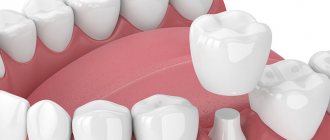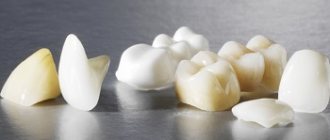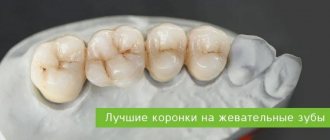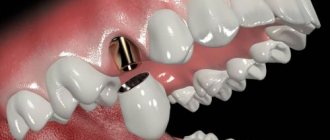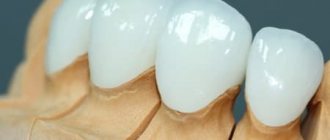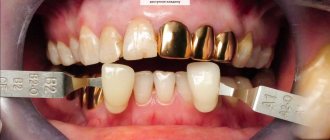Features of a temporary crown on an implant
After implantation, a certain period of time must pass before the permanent crown is placed. Over the course of several months, a specialist monitors the osseointegration of the titanium screw. But walking even for several days with a “space” instead of a tooth is extremely uncomfortable. A temporary crown on an implant made of composite material or plastic will help solve the problem. The design does not interfere with the process of engraftment of the artificial root and creates the necessary load for primary stabilization. Due to the fact that special cement dissolves over time under the influence of salivary enzymes, the temporary crown can easily be replaced with a permanent one at the right time.
What are temporary crowns on implants used for?
In addition to maintaining the aesthetics of your smile, temporary crowns placed on titanium roots perform a number of other useful tasks.
- Preparation of soft tissues for the next stage of implantation.
- Providing psychological comfort.
- Helps in the formation of smooth gum edges.
- Protection against bacteria that can cause gum inflammation and implant rejection.
- Maintaining correct diction and bite.
- Restoration of chewing functions.
- Facilitate adaptation to permanent crowns.
- Creating the correct load to stabilize the implant.
Installing a temporary crown on an implant
Not all implantation methods involve installing a temporary crown on the implant. This is only possible when using a one-stage technique with instant loading. As a rule, the method is used to restore front teeth. The possibility of installing a temporary crown on an implant is also associated with the special structure of artificial roots used for one-stage implantation. Firstly, these implants are one-piece, that is, they are already connected to an abutment, onto which the prosthesis is then attached. And secondly, such structures are equipped with a special thread, so they seem to be screwed into the bone tissue without the need to drill out a place in it for the implant, as is done with the two-stage technique. In this regard, implants for a one-stage implantation procedure are attached more securely, and therefore are able to withstand the weight of a temporary crown and normal chewing load from the first days of installation.
Proper care
After placing a temporary crown, there are several restrictions that must be observed. This will ensure the durability of the structure. 5 recommendations that will make your care of temporary crowns correct:
- Avoid too hard foods (crackers, hard apples, nuts, etc.).
- Try not to place too much stress on the side where the implant was placed.
- When brushing your teeth, do not press the toothbrush onto the crown.
- Use dental floss with caution.
- Visit your dentist promptly (for example, if the temporary crown begins to loosen).
For implantation to take place quickly, efficiently and safely, contact professionals. The specialists of the dental clinic “V Put” are ready to cope with a task of any complexity. By contacting us, you make a choice in favor of quality and health!
Do I need a temporary crown for an implant?
Do I need to put temporary crowns on implants? If the operation is performed in the smile area, then it is advisable to do this. Natural pressure when chewing food will activate metabolic processes in bone tissue and stimulate their restoration. Moreover, the installed crown will help achieve a beautiful gum contour and also prevent the loss of soft tissue. As for the implantation of chewing teeth, according to most experts, it is better to carry out the operation in two stages with delayed installation of the crown.
How much does it cost on average in Moscow?
| Name of service | Cost, rub. |
| Installation of the healing abutment | 3700 |
| Installation of a temporary abutment | |
| Standard | 4600 |
| Individual | 9400 |
| Temporary abutment by manufacturer (without dental services) | |
| Implantium | 1000 |
| Alpha Bio | 1050 |
| BioHorizons | 1050 |
| M.I.S. | 1400 |
| Osstem | 1800 |
| Xive | 1900 |
| Nobel Biocare | 2000 |
| Ankylos | 2400 |
Making temporary crowns for implants
Temporary crowns for dental implants are in most cases made of plastic. Please note that metal-ceramics, all-ceramics and zirconium are used to make permanent crowns for implants. If a doctor offers to make a temporary crown, for example, from metal ceramics, think about his honesty and competence. It may happen that the same structure will be installed twice: as a temporary and permanent one. Of course, for a double fee.
How much can you use
The maximum service life of temporary abutments is 6 months, but 2-4 weeks are often sufficient for complete healing of the soft tissue, provided there are no complications. Only a doctor can decide when to remove a structure; you cannot do it yourself. During the first 2-3 days, the patient may experience bleeding, swelling or pain. After a few days they will disappear, if this does not happen, then you should consult a doctor. When the gingival contour has formed, the temporary system is replaced with a permanent one, after which the prosthesis is fixed.
How long does it take to make a temporary crown on an implant?
Direct method.
The doctor takes an impression using silicone mass, pours a plastic solution into it and puts it all on the implant. Once the resin has cured, the silicone impression is removed and the temporary crown remains on the implant. It is given the required shape, polished and ground, and then secured with special cement.
- Quickly produced.
- Similar to natural teeth.
- Porosity, due to which there is a risk of infection.
- Discoloration due to coloring products.
- Short service life.
- More fragile.
Indirect method.
Based on the casts, a plaster model of both jaws is created in the laboratory, which is used to make a wax crown. A temporary plastic crown is created using the wax model. Sometimes, in the manufacture of plastic crowns, a metal base is used to extend the service life of the products.
- More durable compared to crowns made using the direct method.
- The individual characteristics of the patient are taken into account.
- No.
Making temporary crowns for implants using the direct method in an orthopedist’s office will take no more than an hour. A dental laboratory will make a temporary crown made of plastic in a couple of days.
Why you can’t do without temporary abutments
The patient himself can choose whether to install a temporary abutment; someone can ignore this step and refuse this design. Therefore, I would like to explain why the former is so important during implantation. Firstly, due to the absence of this element, the head of the implant may be visible due to insufficient gum tissue. Secondly, the temporary abutment is responsible for the aesthetic result, i.e. Without it, the dental structure will not look natural.
If you want your restored teeth to be no different from living ones, it is recommended to follow all stages of implantation, including not refusing to install a former.
What to do if a temporary crown on an implant falls out or is swaying?
Sometimes temporary crowns on implants begin to wobble due to poor-quality fixation or poor implant abutment. However, there are cases when the patient cannot determine exactly what has become unstable - the temporary crown or the artificial root itself. Therefore, at the first signs of mobility of the temporary prosthesis on the implant, you should immediately contact the doctor who performed the implantation procedure. Only he will be able to correctly determine the condition of the artificial root and more securely attach a temporary crown to it.
How is temporary dental implantation performed?
The diameter of the implant does not exceed 2 mm, but its installation requires pinpoint precision. The procedure can be performed by a dental surgeon with the appropriate qualifications: implantology or maxillofacial surgery. The doctor must know the anatomy thoroughly so as not to damage the nerves, important vessels, and maxillary sinuses.
When examining the patient, contraindications are excluded and the method of anesthesia is selected. The oral cavity is first sanitized: tartar is removed, caries and other diseases are treated to reduce the risk of tissue infection.
The operation is performed in stages:
- anesthesia;
- antiseptic treatment;
- drilling the bone;
- screwing the pin into the prepared bed;
- installation of an artificial crown.
During the procedure, the surgical field is constantly treated with antiseptics. There are no stitches because the gum is not cut. After surgery, the patient must follow medical recommendations to prevent infection and the development of inflammation.
Why are temporary crowns placed before permanent ones?
It may seem that a temporary crown is an extra material cost and should not be included in the cost of prosthetics.
Let us dwell once again on the need to use temporary crowns and emphasize their main advantages.
- Psychological calm.
Imitating your own teeth allows you to maintain self-confidence without introducing an imbalance in your daily activities (during business negotiations, smiling, talking, etc.). - Safety of soft tissues of the oral cavity
(prevention of inflammation and atrophy). - Preserving the functionality of teeth.
Thanks to the complete chewing process, possible undesirable consequences for the digestive system are eliminated. - No problems with diction.
- Fast adaptation.
Getting used to the future permanent prosthesis is much easier if you wear temporary crowns first. - Economy.
A temporary crown is a quick “reanimation” of teeth at an affordable cost.
Alternative solutions
The only alternative to a metal-plastic prosthesis at the first stage of prosthetics after installation of implants can only be a ceramic-composite prosthesis. In general, the final cost of basal implantation using both types of structures is identical. Those. when undergoing re-prosthetics, the patient will have to pay an additional 150 thousand rubles (depending on the material) for the manufacture of a permanent prosthesis. Therefore, the only difference is the necessity or absence of the second stage of prosthetics, as well as the amount that will have to be paid immediately at the time of concluding a contract for dental implantation.
How long can you walk with a temporary crown?
Temporary crowns are a quick restoration of the aesthetics and functionality of teeth until permanent dentures are installed. Their service life is the time required to create permanent orthopedic structures, as well as implant healing. When can a permanent prosthesis be installed on an implant? Up to 4 months is the healing period of the implant in the lower jaw, up to 6 months in the upper jaw. After this, permanent dental prosthetics can be performed.
In some cases, for example, after implantation of All-on-4, All-on-6, a temporary prosthesis can last up to two years. During this time, the patient will have time to financially prepare for the installation of a high-quality permanent prosthesis. If the patient uses a temporary crown for a long time, it is necessary to come to the clinic every six months for a preventive examination. When worn for a long time, the following complications may occur:
✔
abrasion of crowns, leading to displacement of adjacent teeth;
✔
inflammation of the gums due to the accumulation of bacteria on plastic;
✔
gum growth and pain due to damage to the crown.
To make a temporary crown on an implant last longer:
- avoid sticky and hard foods;
- brush your teeth gently, without pressing hard on the area where the implant is installed;
- floss as carefully as possible.
Indications and contraindications
Functional tasks implemented using temporary abutments allow the products to be used to solve the following problems:
- Restoration of the gum contour;
- Formation of a dense tissue radius;
- Prevention when installing a prosthesis;
- Preventing the socket from becoming overgrown, leading to tissue subsidence.
The list of medical factors limiting the possibility of using the structure includes:
- Inflammatory processes affecting periodontal tissues;
- Loose fixation of the integrated implant;
- Lack of sufficient contact in the area of the pin;
- Pathological manifestations localized in the area of integration.
The stability of the position of the implanted titanium rod is a key indicator when choosing a product placed for the adaptation period. In situations where the fit density meets the established criteria, it is possible to replace the temporary abutment with a full-fledged crown used for express prosthetics.
